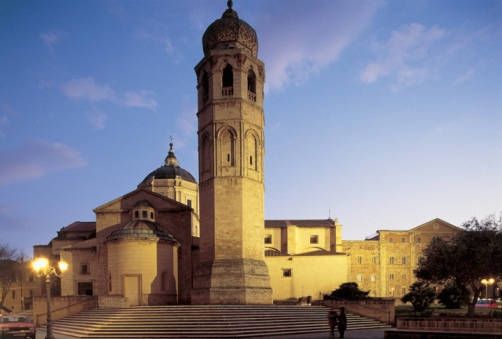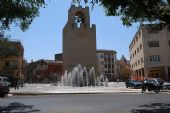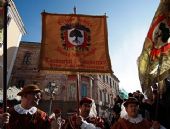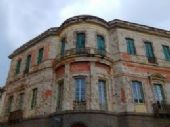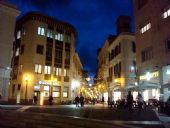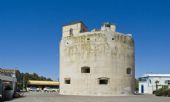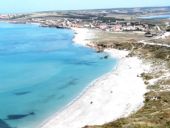
Oristano
capital of western Sardinia
The town of Oristano is located south of the river Tirso, in the center of the vast plain of the Campidano of Oristano, a short distance from the sea, it was founded in the eleventh century. becoming the capital of the court of Arborea in 1070.
The visit to the old town is to discover a village full of ideas of historical and artistic interest.
In Rome square stands the Tower of Mariano II, also known as Porta Maggiore or St. Christopher, the original testimony of medieval walls.
The oldest part of the city is gathered around the square Eleanor where there is a monument dedicated to the most significant woman in Italian history, Eleanor, judge of Arborea from 1383 to 1404, and the Town Hall, a former convent Scolopi.
A few meters away, the Cathedral of the Assumption, imposing style building composite built in the thirteenth century. flanked by a majestic octagonal tower with terminal clearly baroque. Opposite is the typical building of the Tridentine Seminary Arborense and also the church of St. Francis, in the neoclassical style.
Very interesting to visit Antiquarium Arborense in Parpaglia palace, the most important museum of the province that contains testimonies from Punic and Roman Tharros and the Sinai Peninsula, as well as artifacts nuragici and valuable paintings.
Among the alleys of the old building also emerge De Castro, the church of San Domenico and especially the church of Santa Chiara, built in 1343. Valuable sober example of Rococo style is the church of Ns. Lady of Mount Carmel was built by the family of Arcais, as evidenced by the coat of arms on the facade.
At the end of Via Garibaldi, stands the tower Portixedda, the fifteenth-century fortification, based in truncated cone surmounted by a mighty cylindrical shape.
Outside the city, to the north, it suggests a visit to the Shrine of Our Lady of Remedy, which each year (September 8) welcomes the great feast of the Virgin, attracting a large number of faithful. Following directions to the sea, you get to Marina di Torregrande and to its wide beach dominated by the Gran Torre, the greater the one hundred built by the Spanish in the sixteenth century.
A ten km. from the city to the north-west, on the bottom of the pond of Càbras, it is Riola Sardo and Baratili, agricultural centers known for producing the famous Vernaccia; do not miss the seventeenth-century aristocratic mansion of the Charter and the parish of St. Martin (XVI sec.) with octagonal belfry typical dell'oristanese.
Another stop is the center of Solarussa, a dozen km., Whose fame is linked to the production of vegetables and wines, including the aforementioned aVernaccia.
A 20 km to the north, taking in Milis, where the parish church of St. Paul, you can admire works by Catalan masters; just beyond, following the highway, there is the Reserve oriented S. Vero Milis, where you can admire a beautiful landscape of flamingos.
Along the road to Cagliari it is one of the most beautiful churches in the Pisan Romanesque basilica of St. Giusta, built in 1145 on a small hill on the eastern shore of the pond. The fishy pond of St.Giusta, lying in a charming landscape, is a valuable biotope extended until the Wetland of Pauli Maiori, where there is a fine bird.
The visit to the old town is to discover a village full of ideas of historical and artistic interest.
In Rome square stands the Tower of Mariano II, also known as Porta Maggiore or St. Christopher, the original testimony of medieval walls.
The oldest part of the city is gathered around the square Eleanor where there is a monument dedicated to the most significant woman in Italian history, Eleanor, judge of Arborea from 1383 to 1404, and the Town Hall, a former convent Scolopi.
A few meters away, the Cathedral of the Assumption, imposing style building composite built in the thirteenth century. flanked by a majestic octagonal tower with terminal clearly baroque. Opposite is the typical building of the Tridentine Seminary Arborense and also the church of St. Francis, in the neoclassical style.
Very interesting to visit Antiquarium Arborense in Parpaglia palace, the most important museum of the province that contains testimonies from Punic and Roman Tharros and the Sinai Peninsula, as well as artifacts nuragici and valuable paintings.
Among the alleys of the old building also emerge De Castro, the church of San Domenico and especially the church of Santa Chiara, built in 1343. Valuable sober example of Rococo style is the church of Ns. Lady of Mount Carmel was built by the family of Arcais, as evidenced by the coat of arms on the facade.
At the end of Via Garibaldi, stands the tower Portixedda, the fifteenth-century fortification, based in truncated cone surmounted by a mighty cylindrical shape.
Outside the city, to the north, it suggests a visit to the Shrine of Our Lady of Remedy, which each year (September 8) welcomes the great feast of the Virgin, attracting a large number of faithful. Following directions to the sea, you get to Marina di Torregrande and to its wide beach dominated by the Gran Torre, the greater the one hundred built by the Spanish in the sixteenth century.
A ten km. from the city to the north-west, on the bottom of the pond of Càbras, it is Riola Sardo and Baratili, agricultural centers known for producing the famous Vernaccia; do not miss the seventeenth-century aristocratic mansion of the Charter and the parish of St. Martin (XVI sec.) with octagonal belfry typical dell'oristanese.
Another stop is the center of Solarussa, a dozen km., Whose fame is linked to the production of vegetables and wines, including the aforementioned aVernaccia.
A 20 km to the north, taking in Milis, where the parish church of St. Paul, you can admire works by Catalan masters; just beyond, following the highway, there is the Reserve oriented S. Vero Milis, where you can admire a beautiful landscape of flamingos.
Along the road to Cagliari it is one of the most beautiful churches in the Pisan Romanesque basilica of St. Giusta, built in 1145 on a small hill on the eastern shore of the pond. The fishy pond of St.Giusta, lying in a charming landscape, is a valuable biotope extended until the Wetland of Pauli Maiori, where there is a fine bird.
- Related products
- Municipal Museum of Cabras
- Oristano and the province
-
Search
-
Categories
- APP FAITA Sardegna
- HOLIDAY PACKAGES
- CAMPING VILLAGE Sardinia
- Where to eat
- TRANSPORT Sardinia
- BEACHES in Sardinia
- Tours in Sardinia
- KITCHEN traditional Sardinian
- WINES Sardinia
- SPIRITS of Sardinia
- EVENTS in Sardinia
- CORTES Apertas in Sardinia
- SPORT in Sardinia
- MAP Sardinia
- PHOTOS Sardinia
- VIDEO Sardinia
- Useful Numbers Sardinia
- DOGGIE BEACH in Sardinia
- Contact information
- archivio
-
Topics
- Camping e Village Sardinia
- Tourism in Sardinia
- resorts in Sardinia
- Sardinian beaches routes
- Specialties at the table
- South Coast Cagliari
- Costa Rei itinerari
- Ogliastra itinerari
- Nuoro e provincia itinerari
- Gallura itinerari
- Sassari e provincia itinerari
- Oristano e provincia itinerari
- Autunno in Barbagia 2013
- Aerei per la Sardegna
- Traghetti per la Sardegna
- Storia di Sardegna
- Feste e sagre della Sardegna
- Camping Village e Spiagge dog friendly
- Spiagge accessibili con l'amico cane
-
Geo Map
- Sardinia
- Cagliari
- Carbonia-Iglesias
- Medio Campidano
- Nuoro
- Ogliastra
- Olbia-Tempio
- Oristano
- Abbasanta
- Aidomaggiore
- Albagiara
- Ales
- Allai
- Arborea
- Ardauli
- Assolo
- Asuni
- Baradili
- Baratili San Pietro
- Baressa
- Bauladu
- Bidoni'
- Bonarcado
- Boroneddu
- Bosa
- Busachi
- Cabras
- Cuglieri
- Curcuris
- Flussio
- Fordongianus
- Genoni
- Ghilarza
- Gonnoscodina
- Gonnosno'
- Gonnostramatza
- Laconi
- Magomadas
- Marrubiu
- Masullas
- Milis
- Modolo
- Mogorella
- Mogoro
- Montresta
- Morgongiori
- Narbolia
- Neoneli
- Norbello
- Nughedu Santa Vittoria
- Nurachi
- Nureci
- Ollastra Simaxis
- Oristano
- Palmas Arborea
- Pau
- Paulilatino
- Pompu
- Riola Sardo
- Ruinas
- Sagama
- Samugheo
- San Nicolo' D'Arcidano
- San Vero Milis
- Santa Giusta
- Sant'Antonio Ruinas
- Santu Lussurgiu
- Scano Di Montiferro
- Sedilo
- Seneghe
- Senis
- Sennariolo
- Siamaggiore
- Siamanna
- Siapiccia
- Simala
- Simaxis
- Sini
- Siris
- Soddi'
- Solarussa
- Sorradile
- Suni
- Tadasuni
- Terralba
- Tinnura
- Tramatza
- Tresnuraghes
- Ula' Tirso
- Uras
- Usellus
- Villa Sant'Antonio
- Villa Verde
- Villanova Truschedu
- Villaurbana
- Zeddiani
- Zerfaliu
- Sassari
- Sardinia






